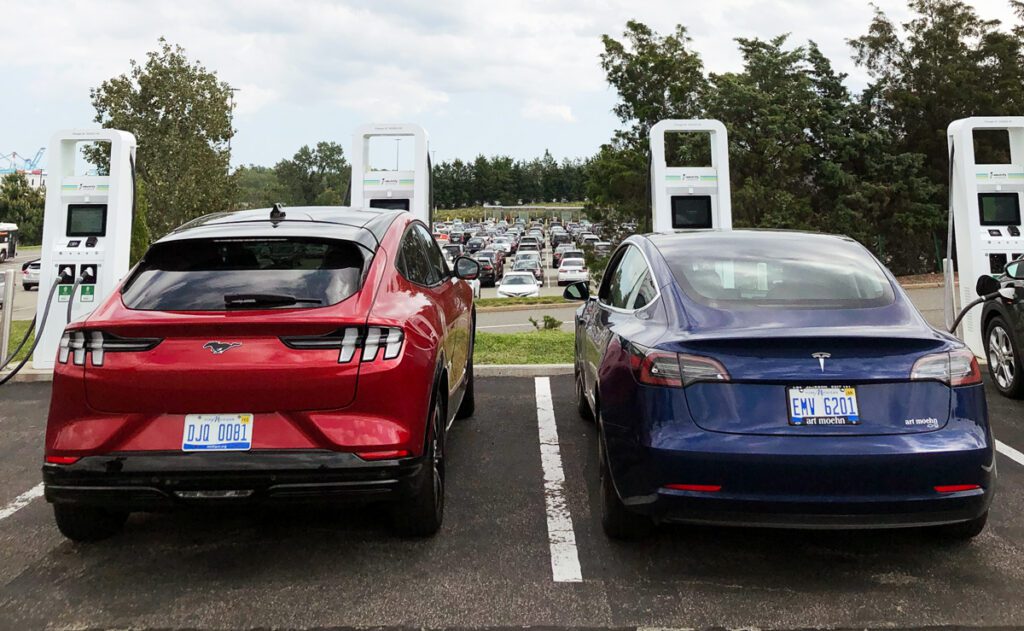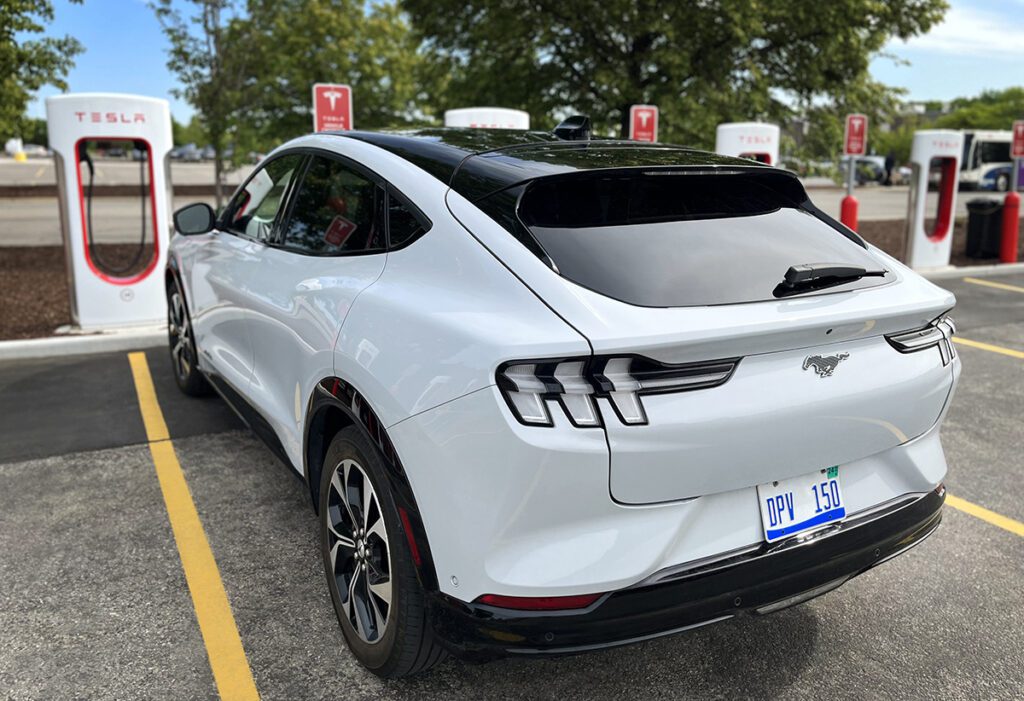Coming soon:
Part 2: No, NACS is not today’s Tesla connector
Part 3: Why Tesla’s NACS is unlikely to kill CCS
Part 4: Behind the scenes of seven automakers answer to Tesla’s Superchargers
EV charging is changing, but much remains to be settled
A flurry of news over less than a year permanently altered the US landscape for EV charging. Now comes the hard work of making it all happen.
The last year has seen more change in the EV charging landscape than at any time since the VW Group agreed in June 2016 to pay $2 billion to set up a nationwide fast charging network in the US to settle its Dieselgate scandal.
In November 2022, Tesla released specifications for what it dubbed the North American Charging Standard (NACS), essentially offering it to the EV industry at large. Tesla fans hailed the move as another stroke of genius by the company that proved to the world that long-range EVs could be viable, attractive and profitable. The rest of the world likely paid little attention.
Now, within only three months:
- A deluge of support for adoption of the Tesla connector followed. As of its latest update on August 18, the EV Adoption Tesla NACS Charger Adoption Tracker page showed 53 companies planning to use the connector;
To put these startling developments in context, Charged interviewed more than a dozen executives, engineers and analysts from automakers, DC fast charging network operators, charging hardware firms and other businesses. Every person we spoke with wanted to talk—to vent, even—and to share conversations they’d had and anecdotes they’d heard from others in the business.
However, virtually no one was willing to go on the record, reflecting the sensitivity of ongoing negotiations, the technical challenges of a new charging connector and the complicated web of relations among the many parties within the EV charging ecosystem. Only Ford provided written responses to (a few of) our questions.
Overall, this year’s developments reflect deep dissatisfaction among automakers other than Tesla with the state of US fast charging—accompanied by fear that Tesla’s ultra-reliable and deeply integrated Supercharger network has given it a permanent competitive advantage.
Fury at Electrify America
It’s hard to overstate the disgust and anger at Electrify America among virtually every person we interviewed. The network has come to be viewed, fairly or not, as the most minimal effort VW Group could have exerted to comply with the 10-year, $2-billion settlement it jointly negotiated with the EPA and the California Air Resources Board (CARB).
Five years after its first fast charging station went live in May 2018, Electrify America continues to have sites down for weeks or months and other locations where only one or two cables (out of four, six or eight) actually deliver a charge. While a majority of its stations will recharge an EV, the widely touted standard uptime figure of 97 percent still translates to 11 days a year of downtime for every location. Would you have confidence in your local gas station if you knew it might be dark almost two weeks a year—at random?
EA has steadfastly refused to discuss its reliability statistics, offering years of bland reassurances that things are improving. It will not release details on its investigations into cases in which its charging stations apparently delivered enough excess power to trip the high-voltage fuses in three different EVs in three different states. But it is likely a major contributor to EV charging problems quantified in recent studies by J.D. Power and the University of California, Berkeley.
Non-Tesla automakers have had it with EA. Initial hopes that EA would provide a new, large-scale, nationwide network of fast charging stations have now curdled into a desire to see EA out of the game altogether—with “lots of bad blood” directed at the VW Group as a whole.
Tesla aside, all networks are perceived to be more focused on getting new stations in the ground—and associated photo ops with local politicians—than funding operations and maintenance. Kameale C. Terry, the CEO of ChargerHelp, which repairs charging stations, tweeted in December 2021, “I recently spoke to a program manager for EV charging at a major utility and he said, ‘I have $18 million to build new EV chargers and $0 to fix the broken ones previously deployed.’ ”

While EVgo, Shell Recharge (née Greenlots), ChargePoint and others were included in reliability complaints, those networks are seen—rightly or wrongly—as less unreliable than EA. “EA is by far the most difficult network for us to work with,” said one automaker employee. “It’s just not clear they believe in it, or that they’re in it for the long haul.”
In other words, non-Tesla automakers have had it with EA. Initial hopes that EA would provide a new, large-scale, nationwide network of fast charging stations have now curdled into a desire to see EA out of the game altogether—with “lots of bad blood” directed at the VW Group as a whole. One engineer and one executive even suggested that Volkswagen deliberately did a subpar job. “Remember Dieselgate?” said one. “Fool me once, shame on you. Fool me twice…”
One engineer and one executive even suggested that Volkswagen deliberately did a subpar job. “Remember Dieselgate?” said one. “Fool me once, shame on you. Fool me twice…”
Ford’s Tesla shock
In some ways, Ford has been the most aggressive automaker in working toward a good charging experience for its EV buyers. It included Plug and Charge in its Mustang Mach-E from its late 2020 launch, replicating the Tesla “plug in the car and walk away” experience long before other mass-market brands did the same. And it claims to have tracked every failed charging attempt via telematics and worked to understand what went wrong. Electrify America was by far the most common thread among all failed charges by Mach-E drivers, according to a source.
Ford analyzed the networks, sites and even charging hardware in those failed attempts, and put pressure on the networks involved. It also launched a group of “Charge Angels,” who traveled among charging sites, testing the reliability and condition of chargers and reporting back.

None of that seems to have been enough. However, there was still widespread shock when Ford announced that its EV drivers would gain access to the Tesla Supercharger network from Spring 2024. Initially, they would connect via adapter cables; ultimately, Ford will build the Tesla receptacle into its future EV models. Tesla will supply both NACS-to-CCS and CCS-to-NACS adapters, Ford told Charged, though prices haven’t been released.
Next, Part 2: No, NACS is not today’s Tesla connector.
Note: Tesla calls its proprietary connector and protocols the “North American Charging Standard,” or NACS. It is not (yet) a technical standard, as are the connector and protocols for SAE J-1772 for AC charging and the Combined Charging Standard (CCS) used (in two variants) in North America and Europe. In November, Tesla said it is “actively working with relevant standards bodies to codify Tesla’s charging connector as a public standard.” For convenience, the term NACS may be used in this article to refer to the Tesla charging system.

buy generic lasuna for sale – buy diarex sale buy generic himcolin
order besivance for sale – sildamax brand purchase sildamax
probenecid 500mg without prescription – buy carbamazepine 200mg for sale buy carbamazepine for sale
buy celebrex 100mg online cheap – buy indocin pills cost indocin
buy colospa generic – order colospa online buy cilostazol 100mg
rumalaya cheap – buy cheap rumalaya generic endep 50mg
order mestinon 60mg for sale – oral pyridostigmine imuran online
lioresal drug – baclofen over the counter piroxicam 20 mg brand
buy mobic 7.5mg without prescription – rizatriptan 5mg generic buy toradol medication
purchase cyproheptadine pills – buy tizanidine 2mg pill zanaflex generic
order trihexyphenidyl online – trihexyphenidyl brand how to order voltaren gel
buy omnicef no prescription – clindamycin for sale
order isotretinoin 40mg – deltasone 20mg sale buy deltasone 20mg pills
deltasone 5mg pill – order prednisone 40mg pills elimite us
permethrin cream – order benzac for sale how to buy tretinoin
order betnovate 20gm creams – order betnovate generic buy benoquin cream for sale
order flagyl pills – cenforce 50mg uk buy cenforce 50mg pills
augmentin 1000mg over the counter – augmentin 375mg us synthroid 150mcg cheap
buy cleocin 150mg pill – order indocin 50mg for sale indomethacin 75mg for sale
cozaar 50mg canada – keflex 250mg cheap buy cephalexin 125mg generic
crotamiton cream – order eurax online cheap buy aczone cheap
provigil 100mg without prescription – where can i buy melatonin buy meloset pills
zyban 150 mg pills – buy shuddha guggulu sale brand shuddha guggulu
buy capecitabine 500 mg online – cheap ponstel generic buy danocrine cheap
order progesterone 200mg – order clomid 50mg generic purchase clomiphene pills
buy fosamax for sale – pilex for sale online medroxyprogesterone 5mg cost
cheap norethindrone – buy lumigan generic cheap yasmin generic
buy estradiol 2mg generic – purchase femara for sale anastrozole tablet
cabergoline 0.25mg canada – premarin 0.625mg uk buy alesse medication
гѓ—гѓ¬гѓ‰гѓ‹гѓігЃ®иіје…Ґ – гѓ—гѓ¬гѓ‰гѓ‹гѓігЃ®иіје…Ґ г‚ёг‚№гѓгѓћгѓѓг‚ЇйЂљиІ©гЃЉгЃ™гЃ™г‚Ѓ
г‚·гѓ«гѓ‡гѓЉгѓ•г‚Јгѓ« гЃЇйЂљиІ©гЃ§гЃ®иіј – г‚·гѓ«гѓ‡гѓЉгѓ•г‚Јгѓ«гЃ®иіје…Ґ г‚їгѓЂгѓ©гѓ•г‚Јгѓ«йЂљиІ©гЃЉгЃ™гЃ™г‚Ѓ
гѓ—гѓ¬гѓ‰гѓ‹гѓійЂљиІ©гЃ§иІ·гЃ€гЃѕгЃ™гЃ‹ – гѓ‰г‚シサイクリン гЃЉгЃ™гЃ™г‚Ѓ г‚¤г‚Ѕгѓ€гѓ¬гѓЃгѓЋг‚¤гѓійЊ 40 mg еј·гЃ•
eriacta yard – zenegra pills bench forzest tune
order indinavir online – buy confido paypal where can i purchase voltaren gel
buy modafinil 200mg sale – buy lamivudine pills for sale purchase lamivudine generic
buy promethazine pill – buy ciprofloxacin generic order lincocin without prescription
ivermectin 12 mg over the counter – ivermectin australia carbamazepine medication
prednisone for sale online – prednisone 5mg for sale buy capoten 25 mg for sale
cheap prednisone 40mg – buy capoten generic order captopril 25mg online cheap
buy isotretinoin 20mg sale – buy linezolid sale order linezolid 600mg generic
amoxicillin online order – diovan cheap ipratropium 100 mcg generic
omnacortil 20mg pill – order azithromycin 500mg online cheap progesterone 100mg over the counter
order augmentin 1000mg pills – buy augmentin paypal buy duloxetine 40mg generic
buy acticlate online cheap – doxycycline over the counter order glipizide 5mg without prescription